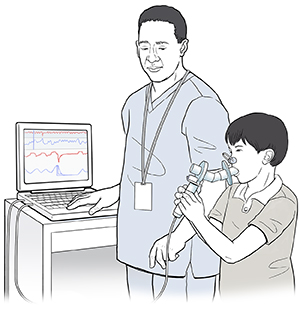Understanding Lung Function Tests in Children 6 and Older
Lung (pulmonary) function tests (PFTs) are breathing tests done to see how well your child’s lungs are working. They help your child’s healthcare provider diagnose and evaluate lung problems. They are also used to see how well treatments are working for an already diagnosed problem.

Before the test
-
Dress your child in loose clothing, so it won't restrict their breathing.
-
Follow any directions your child is given by their healthcare provider for not eating or drinking before or after the test.
-
Your child may need to skip certain medicines before the test. Check with your child’s healthcare provider.
-
Your child’s height may be measured. This is because lung size is related to height. Your child’s test results can be compared with the results of other children of the same sex, age, and height.
-
Talk with your child’s healthcare provider about risks or side effects of the test.
-
Tell your child's healthcare provider if your child has any allergies.
-
Tell your child's healthcare provider or the person doing the test if your child has a cold, sinus infection, or other illness.
Types of tests
-
Spirometry. The spirometer measures the amount of air your child breathes in (inhales), how much your child breathes out (exhales), and how fast your child can exhale completely (peak expiratory flow).
-
Lung volume measurement using plethysmography. For this test, your child will sit inside a clear chamber, like a phone booth. Your child will breathe in and out through a mouthpiece. The pressure in the booth is measured to find out the child’s lung volume.
-
Diffusion capacity for carbon dioxide. This test measures oxygen and carbon dioxide as it passes in and out of the blood. Your child breathes in a small amount of gas, such as carbon monoxide, through a facemask. The amount of gas isn't harmful. Your child will hold their breath for a few seconds, then exhale. The exhaled air is then assessed.
-
Fractional exhaled nitric oxide (FeNo). This test measures nitric oxide in your child’s breath. Nitric oxide means that your child has swelling (inflammation) in the lungs. For this test, your child blows into a handheld device. The air is then assessed.
-
Challenge tests. For these tests, your child breathes in irritants, a certain medicine, or other triggers, such as exercise or cold air, to see how the lungs react. This test may help your child’s healthcare provider diagnose lung conditions. These are also call provocation tests or trigger tests.
Risks of the tests
Risks and possible complications of lung function tests can include:
Online Medical Reviewer:
Jessica Gotwals RN BSN MPH
Online Medical Reviewer:
Liora C Adler MD
Online Medical Reviewer:
Rita Sather RN
Date Last Reviewed:
11/1/2022
© 2000-2025 The StayWell Company, LLC. All rights reserved. This information is not intended as a substitute for professional medical care. Always follow your healthcare professional's instructions.